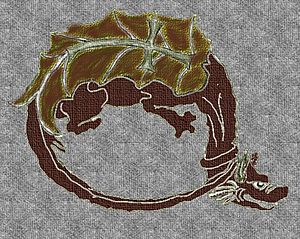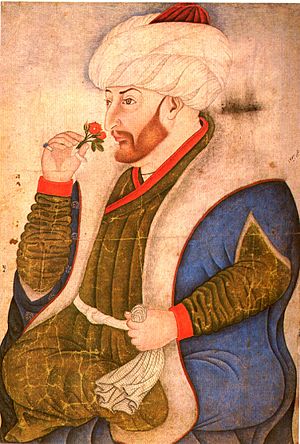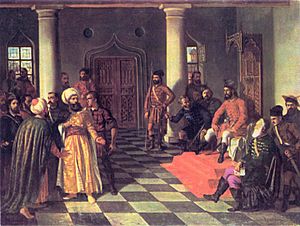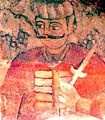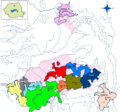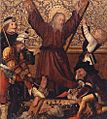Vlad the Impaler facts for kids
Quick facts for kids Vlad III DraculaВладъ Цепѣшъ |
|
|---|---|
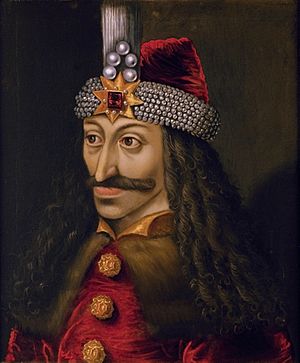
The Ambras Castle portrait of Vlad III, c. 1560, reputedly a copy of an original made during his lifetime.
|
|
| Voivode of Wallachia | |
| Reign | 1448; 1456–1462; 1476 |
| Born | November or December 1431 Segesvár, Kingdom of Hungary (city now known as Sighișoara, Romania) |
| Died | December 1476 or January 1477, exact date unknown (aged 44/45) Wallachia (exact location unknown) |
| House | House of Drăculești (branch of the House of Basarab) |
| Father | Vlad II Dracul |
| Mother | Cneajna of Moldavia (presumed) |
Vlad III, Prince of Wallachia, is better known as Vlad the Impaler. He was born in Sighișoara, Transylvania, Kingdom of Hungary, in 1431. He was the Prince of Wallachia and ruled three times: in 1448, from 1456 to 1462, and in 1476.
In the English-speaking world, Vlad is famous for stories about his cruelty. These stories gave Bram Stoker the idea for his main character in the popular Dracula novel.
Contents
Wallachia's Historical Setting
Wallachia was a country located between the Kingdom of Hungary and the powerful Ottoman Empire. The Turks were often fighting against Hungary. This made Wallachia a battleground between these two big powers.
The rulers of Wallachia were chosen by Romanian nobles called boyars. The ruler was often from a noble family. Sometimes, it was a prince born outside of marriage. The country's leaders often struggled with each other. This led to a lot of instability and changes in power.
Vlad's Early Life and Family
Vlad's Family Background
Vlad the Impaler was born in 1431. His father was Vlad II Dracul. His mother is not fully known, but Vlad II was married to Princess Cneajna of Moldavia. He also had other partners. Vlad III was raised by Cneajna and her household.
He had two brothers: Mircea, born around 1430, and Radu, born in 1435. He also had a half-brother, Vlad the Monk, born around 1425-1430.
When he was young, Vlad II went to the court of the Holy Roman Emperor, Sigismund of Luxemburg. Sigismund supported Vlad II to become the ruler of Wallachia. In 1431, Sigismund made Vlad II a knight of the Order of the Dragon.
Vlad's oldest brother, Mircea, was sent by their father to fight in a war against the Turks in 1444. This war, called the Battle of Varna, was lost. Mircea and his father died in 1447.
Vlad's half-brother, Vlad the Monk, waited in Transylvania for a chance to rule Wallachia. He became a monk before becoming prince of Wallachia in 1482.
Radu, also known as Radu III the Fair or Radu the Handsome, was Vlad's youngest brother. He was also Vlad’s main rival. Radu often tried to take Vlad's place on the throne.
Vlad's Marriages and Children
Vlad the Impaler had a son from his first marriage. This son later became Prince of Wallachia, known as Mihnea the Evil. We do not know the name of Vlad's first wife. She died during a war in 1462. Vlad III the Impaler was fighting against the Turks at that time.
A legend says that the Turkish army surrounded Vlad's castle, the Poienari Castle. The army was led by his brother, Radu the Handsome. Vlad's wife supposedly threw herself off the castle tower into the Argeş River below. The legend says she declared she "would rather have her body be eaten by the fish of the Argeş than be captured by the Turks."
Vlad had two more sons with his second wife, Ilona Szilágyi. She was a cousin of King Matthias Corvinus of Hungary. Some historians believe they might have also had a daughter named Maria.
Vlad's Early Years
Vlad was most likely born in the city of Sighişoara in Transylvania. This was part of the Kingdom of Hungary in the winter of 1431. Sighişoara was a military fort back then. He was the second son of Vlad Dracul. He had an older brother, Mircea, and a younger brother, Radu the Handsome.
Even though his home country was Wallachia, his family lived away in Transylvania. This was because his father had been forced out by boyars who supported the Ottoman Empire.
A Hostage of the Ottoman Empire
Vlad's father was pressured by the Turkish Ottoman sultan. He promised to be loyal to the Sultan. To keep his promise, he gave his two younger sons, Vlad and Radu, as hostages.
Vlad suffered a lot while with the Ottomans. He was kept in an underground prison. However, his younger brother, Radu, caught the eye of the sultan's son. Radu was freed and became a Muslim. He was allowed to live in the Ottoman royal court.
These years greatly affected Vlad. They shaped his personality. He was often whipped and beaten by the Turks for being stubborn and rude. He grew to strongly dislike Radu and Mehmed, who would later become the sultan.
Short Rule and Exile
By this time, Vlad's father and older brother Mircea had died. The Turks invaded Wallachia. The Sultan put Vlad III on the throne as a ruler he could control. But Vlad's rule was very short. Hunyadi, a Hungarian leader, invaded Wallachia and drove Vlad away the same year. Vlad escaped to Moldavia and was protected by his uncle, Bogdan II.
Warfare and Return to Power
Bogdan was killed. Vlad took this chance and fled to Hungary. Hunyadi was impressed by Vlad's knowledge of the Ottoman Empire. He forgave Vlad and took him in as an adviser. Later, Hunyadi made Vlad Hungary's choice for the throne of Wallachia.
In 1456, Hungary invaded Serbia to push back the Turks. At the same time, Vlad III invaded Wallachia. Both invasions were successful. Hunyadi suddenly died from the plague. Vlad then became prince of Wallachia.
Vlad's Main Reign (1456–1462)
Vlad spent most of his time at the court in the city of Târgovişte. He created laws, met with foreign ambassadors, and decided cases in trials. He made some castles stronger. He probably also enjoyed hunting with his friends.
Wallachia had been in a constant state of war since his grandfather, Mircea the Elder, died in 1418. This led to more crime and less farming. Trade had almost stopped in Wallachia.
Vlad tried to fix these problems using very strict methods. He wanted his country to be strong economically.
Vlad wanted to remove all threats to his power. These were mainly rival noble groups, like the boyars. He did this by killing them and reducing their wealth and influence. The Wallachian nobility had connections with the Saxon merchants. These Saxons lived in the free towns of Transylvania and helped trade grow. Vlad cut off their trade rights with Wallachia and started a war against them.
Vlad gave important positions in his Prince’s Council to people of lower rank who were loyal to him. Vlad preferred to make free peasants into knights.
Vlad III was always careful about the Dăneşti family, who were rivals. Some of his attacks into Transylvania might have been attempts to kill or capture Dăneşti princes. Several members of the Dăneşti family died because of Vlad. Stories say that thousands of people from the free towns who helped his rivals were impaled by Vlad. One captured Dăneşti prince was forced to read his own funeral speech while kneeling at an open grave before he was executed.
Vlad's Personal Crusade
There was a war between the Ottoman Empire and the Hungarian Kingdom. Following his family's traditions, Vlad decided to side with the Hungarians. Towards the end of the 1450s, there was talk again about a war against the Turks. The king of Hungary, Matthias Corvinus, was expected to play the main role.
Knowing this, Vlad stopped paying money to the Ottomans in 1459. Around 1460, he made a new alliance with Corvinus. The Turks did not like this and tried to remove him from power, but they failed. In the winter of 1461, Vlad attacked and destroyed the area between Serbia and the Black Sea. Over 20,000 people died.
In response, the Sultan Mehmed II marched towards Wallachia with an army of 60,000 men in the spring of 1462. Vlad had an army of 20,000 to 30,000 men. He could not stop the Turks from entering Wallachia. The Turks took over the capital, Târgovişte, on June 4, 1462, and drove Vlad away. Vlad hid and made small attacks on the Turks. On the night of June 16, Vlad and some of his men entered the main Turkish camp. They wore Turkish clothes and tried to kill Mehmed. Later, the Turkish army left. They put Vlad’s brother, Radu the Handsome, as the new ruler.
Radu the Handsome gained support from the nobles. Vlad fled to Hungary. In August 1462, Radu made a deal with the Hungarian Crown.
Years in Captivity
Vlad lived in exile because he was afraid of the Wallachian nobles. Vlad escaped to Hungary, but he was put in prison there. The exact time Vlad spent in prison is not fully known. It seems his imprisonment was not too harsh. He slowly managed to gain favor with King Matthias again. He was even able to meet and marry a member of the royal family, the cousin of King Matthias. However, some people do not believe a prisoner would be allowed to marry into the royal family.
He had two sons with his new wife. Vlad also became a member of the Roman Catholic Church. Letters and writings from Buda during this time show that Vlad's actual prison time was short.
Vlad's brother, Radu, openly supported the Turks. This was probably why Vlad was treated well in prison. It is interesting that Russian texts, which usually speak highly of Vlad Ţepeş, say that even in prison he could not stop his favorite activities. He often caught birds and mice and tortured them.
The years before his final release in 1474, Vlad lived with his new wife in a house in the Hungarian capital. He started planning to take back Wallachia. His sons were about ten years old when he took Wallachia back in 1476.
Return to Wallachia and Death
Around 1475, Vlad and Stefan Báthory of Transylvania invaded Wallachia. They had a mixed army of Transylvanians, some unhappy Wallachian nobles, and Moldavians sent by Prince Stephen III of Moldavia, Vlad's cousin. Vlad's brother, Radu the Handsome, had died a few years earlier. Another Turkish choice, Prince Basarab the Elder, a member of the Dăneşti family, had replaced him on the Wallachian throne.
When Vlad's army arrived, Prince Basarab's army fled. Some went to the Turks, others to the mountains. After putting Vlad Ţepeş on the throne, Stephen Báthory and his forces went back to Transylvania. This left Vlad in a very weak position. Vlad had little time to get support before a large Turkish army entered Wallachia. They wanted to put Prince Basarab back on the throne.
Vlad's cruel actions over the years made the nobles believe they had a better chance to survive under Prince Basarab. Even the peasants, tired of Vlad's cruelty, left him. Vlad had to face the Turks with his small forces, which were less than four thousand men.
There are several stories about how Vlad III the Impaler died. Some sources say he was killed in battle against the Turks near Bucharest in December 1476. Others say he was killed by disloyal Wallachian nobles during the war against the Turks, or while hunting. Other reports claim Vlad was accidentally killed by one of his own men. Vlad's body was decapitated by the Turks. His head was sent to Istanbul preserved in honey. The sultan displayed it on a stake to prove that Kazıklı Bey (Vlad's Turkish nickname) was dead. The exact place of his grave is unknown.
Vlad's Legacy and Legends
Stories and legends about Vlad remained a part of folklore among Romanian peasants. By being told again and again, they became mixed up. They created an ideal picture of a great national hero. Among Romanian peasants, Vlad Ţepeş was sometimes remembered as a prince who defended his country.
But sometimes he is remembered as a very cruel and often unpredictable ruler. There are several events that are common to all tales. One tale is about foreign ambassadors whom Vlad Ţepeş met at Târgovişte. All versions agree that Vlad, in response to some real or imagined insult, had their hats nailed to their heads. This might have been because they refused to remove their hats in Vlad's presence.
A good description of Vlad Dracula exists, written by Nicholas of Modrussa:
He was not very tall, but very stocky and strong, with a cruel and terrible appearance, a long straight nose, distended nostrils, a thin and reddish face in which the large wide-open green eyes were enframed by bushy black eyebrows, which made them appear threatening. His face and chin were shaven but for a moustache. The swollen temples increased the bulk of his head. A bull's neck supported the head, from which black curly locks were falling to his wide-shouldered person.
His famous portrait was found again in the late 1800s. It was in the gallery of horrors at Innsbruck's Ambras Castle.
Stories of Vlad's Cruelty
Vlad III Ţepeş has been described as very cruel. The old Romanian word for dragon is Dracul. In modern Romanian, it means "devil". The Wallachians gave Vlad III the nickname Dracul because of his cruelty.
His victims included women, children, peasants, great lords, foreign ambassadors, and merchants. However, most of his European victims were merchants and nobles from Transylvania and Wallachia. Most of the merchants there were German-speaking Saxons. They were seen as bad people because they were not Romanian. He saw the nobles as people who were not loyal. (Vlad's own father and older brother were killed by nobles.)
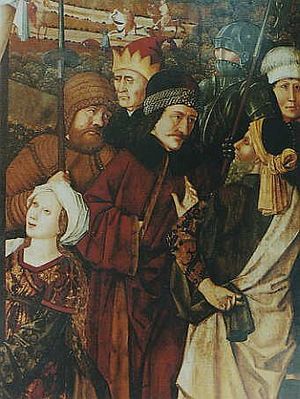
Much of what we know about Vlad III Ţepeş comes from German texts published in the Holy Roman Empire from 1488. There are also books written in Russian. These were a form of entertainment in a society where the printing press was new. The texts were reprinted many times in the thirty years after Vlad's death. The German texts said Vlad Ţepeş was a person who terrorized the land and killed innocent people. The Russian texts said his actions were fair because Vlad helped them. The texts do agree on some details.
According to these texts, he was especially cruel to women. He also wanted his people to work hard. Merchants who cheated their customers were likely to be killed for it.
The Vampire Legend Connection
The fictional vampire in the novel Dracula by Bram Stoker was inspired by the legends of this Wallachian prince. The cruel character of Vlad the Impaler was a good fit for Stoker's story. The events of Vlad's life happened in a part of the world that was still very much like the medieval period in Stoker's time.
Even though there were vampire tales from other places, the vampire, as known in Europe, mostly came from Southern Slavic and Greek folklore. The vampire tale is almost not found in Romanian culture. Vampirism became part of popular culture in Europe starting in the late 17th century. Philosophers in the West began to study this idea. During this time, Dom Augustine Calmet wrote a famous text about vampirism in Hungary. Also, authors and playwrights started to explore the vampire legend. Stoker's novel was one of many works inspired by reports coming from the Balkans.
| Preceded by Vladislav II |
Prince of Wallachia 1448 |
Succeeded by Vladislav II |
| Preceded by Vladislav II |
Prince of Wallachia 1456–1462 |
Succeeded by Radu cel Frumos |
| Preceded by Basarab Laiotă cel Bătrân |
Prince of Wallachia 1475–1476 |
Succeeded by Basarab Laiotă cel Bătrân |
Images for kids
-
The house in the main square of Sighișoara where Vlad's father lived from 1431 to 1435
-
Lands ruled around 1390 by Vlad the Impaler's grandfather, Mircea I of Wallachia (the lands on the right side of the Danube had been lost to the Ottomans before Vlad's reign)
-
Ruins of the Princely Court in Târgoviște
-
The Battle with Torches, a painting by Theodor Aman about Vlad's Night Attack at Târgoviște
-
Renaissance palaces of Matthias Corvinus's summer residence at Visegrád (engraving from the 1480s)
-
Pilate Judging Jesus Christ, 1463, National Gallery, Ljubljana
-
The Martyrdom of Saint Andrew, 1470–1480, Belvedere Galleries
See also
 In Spanish: Vlad Drácula para niños
In Spanish: Vlad Drácula para niños


